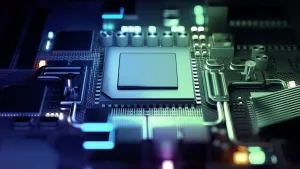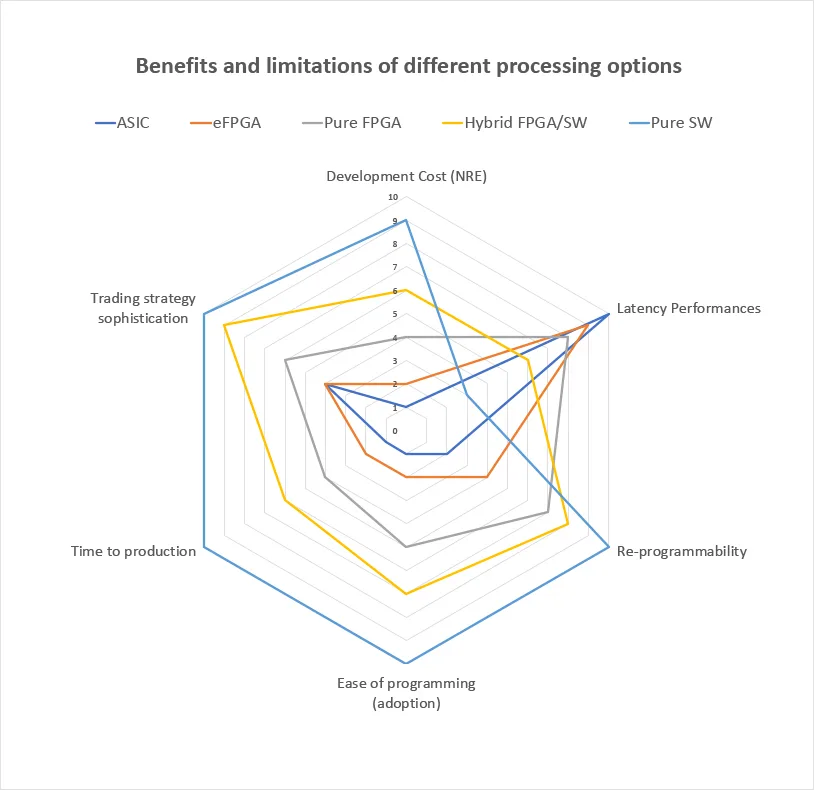
In the fiercely competitive world of trading, where every nanosecond matters, trading firms consistently search for quicker and more efficient solutions to gain an advantage in the race to zero latency.
There’s a broad spectrum of possible solutions for ultra-low latency (ULL) trading, from software-based solutions that operate on the CPU, through intermediate solutions (hybrid FPGA + CPU), to hardware solutions (ASIC, eFPGA, and FPGA). Each presents its own set of strengths and weaknesses. Trading firms must select a solution that can handle the complexity of their desired trading strategy while executing it at the needed speed.
This article will explore the different processing options available for ultra-low latency trading systems. We will highlight the benefits and limitations of each option and provide guidance on which solutions to prioritize based on the essential criteria of your trading strategy.

Software-based solutions can be attractive for ultra-low latency trading systems due to their lower cost and greater flexibility. These solutions rely solely on the CPU for processing, making them easier to develop and maintain without needing a hardware engineer. Since they manage data entirely on the CPU, software solutions are less expensive than hardware ones. Because software developers can implement them without requiring a hardware engineer, these solutions are more straightforward to create and manage. They are also optimal for prototyping and testing trading strategies before implementing them on more specialized hardware solutions due to their enhanced flexibility and ease of modification.
However, since the CPU’s processing power limits the software’s speed, software-based solutions have higher latency and lower performance than hardware-based solutions, making them less suitable for latency-sensitive trading applications where speed is critical.
Despite these limitations, software-based solutions can be cost-effective and adaptable for specific trading applications that don’t require ultra-low latency performance or for prototyping and testing before investing in more specialized hardware solutions.
Hardware-based solutions, including ASICs, eFPGAs, and FPGAs, are specifically engineered for high-performance processing and ultra-low-latency trading. These solutions provide significantly lower latency and superior performance than software-based solutions, making them the preferred choice for latency-sensitive trading applications. More specifically, ASICs or FPGAs offer ultra-low latency processing. They are designed to accelerate many functions in a trading application, from data compression, encryption, and network connectivity to trading algorithms, while low-power, enabling more complex calculations with the same power.
However, hardware-based solutions are more costly to develop and maintain, requiring specialized hardware design expertise, leading to longer development times. Moreover, as they are highly optimized for specific functions, they aren’t as flexible or easy to modify as software-based solutions, making them more challenging to adapt to changing requirements.
By incorporating hardware-based solutions such as ASICs or FPGAs into their trading system, traders can achieve the necessary speed and throughput for success in fast-paced financial markets. These solutions are ideal for trading strategies where ultra-low latency performance and high throughput are critical, while flexibility might be less important. By leveraging the power of these solutions, traders can gain a competitive edge and realize their desired outcomes more efficiently.
Hybrid solutions, which combine FPGA and software-based components, balance software-based solutions’ flexibility and hardware-based solutions’ performance. Typically, FPGAs or eFPGAs accelerate specific functions and algorithms while the CPU handles general-purpose processing and complex trading algorithms.
One of the main advantages of hybrid solutions is their adaptability. Since they operate on a standard CPU platform, developers can effortlessly modify the software component to cater to changing needs or reconfigure the hardware components to support new functions or algorithms. Therefore, the system is highly flexible, delivering very low latency performance.
However, hybrid solutions are more complex to develop and deploy, requiring specialized software and hardware design knowledge. They also exhibit slightly lower performance and higher latency than pure hardware-based solutions. It’s crucial to note that the degree of these drawbacks can depend on the specific allocation of tasks between the hardware and software components. Suppose the FPGA is tasked with accelerating crucial functions while leaving the general-purpose processing to the CPU. In that case, the hybrid solution may still deliver ultra-low latency performance while maintaining flexibility.
In conclusion, when choosing between software-based, hardware-based, or hybrid solutions, it’s vital to consider individual trading needs and preferences. FPGA-based solutions are an outstanding choice for traders requiring both speed and flexibility due to their ability to deliver ultra-low latency and customizability. Ultimately, the choice of these solutions will depend on the specific use case and requirements.
The Orthogone Ultra-low latency FPGA Framework is a hybrid solution for trading systems, melding FPGA hardware acceleration with optimized software development frameworks. Specialized IP cores are incorporated and ready for use, supporting a variety of trading use cases such as tick-to-trade, order routing, risk checks, and exchange interconnects. The framework provides developers with a comprehensive end-to-end FPGA development environment and software framework for creating a portfolio of FPGA applications. With ongoing support, firms can maintain leading-edge performance over time and seamlessly transition to new FPGAs on existing systems, enhancing performance for ultra-low latency trading.
Contact us today to learn more about Orthogone’s products and services.
Quickly develop the ultimate portfolio of flexible FPGA and software applications


